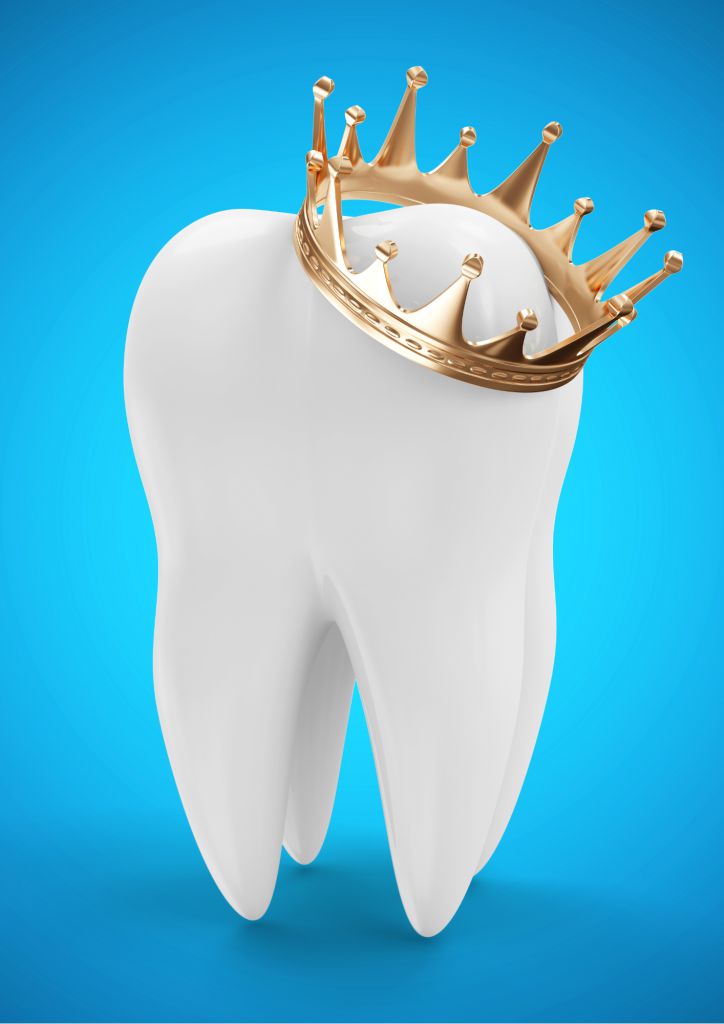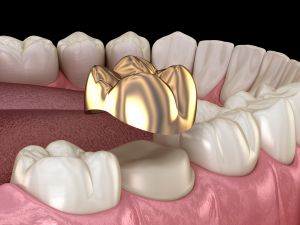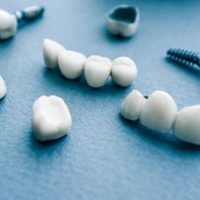
Back in 1728, the dentist Pierre Fauchard, the future of modern orthodontics, came up with an innovative way to treat teeth at the time. He began to cover his damaged teeth with a cap of gold, on which he then applied a thin layer of porcelain. This is how tooth crown widely used today appeared.
A patient in a modern dental clinic can choose the crown material from a wider list – metal, ceramics, high-strength alloys … Which one is preferable you may learn from this article.
Dental crown description
A dental crown is a false tooth that imitates a real one. Its purpose is to save what remains of a damaged tooth, or to replace it completely.
If there is no tooth at all, then a pin or a stump tab (a more reliable option) is inserted into the root canal and a tooth crown is already attached to them. If the tooth is there, but it is in an unsuitable condition, then it is treated as much as possible, root canals are filled, they are grinded 1-2 mm from all sides and then a crown is put on it.
A crown is placed if the tooth is more than half damaged (especially if it was a “dead” tooth – from which the nerve was removed). If the tooth tissue is prone to excessive abrasion, if it is necessary to correct visual imperfections – for example, hide the gap between the teeth. For reference, several dental crowns brazed together are called bridges. It is necessary when two or more teeth are destroyed in a row.
Crowns differ in the type of material used – usually metal alloys, ceramics, and combinations thereof.
There are several dental crown types, such as:
Metal

Installing metal crowns has many advantages. They are convenient, durable, have minimal negative impact on adjacent healthy teeth, are corrosion resistant, have high strength and biocompatibility. Their main drawback is an unaesthetic appearance, for this reason metal crowns are not mounted on the front teeth. But for chewing teeth, they are great.
A contraindication to the installation of metal crowns may be an allergy to certain types of metal, as well as the risk of a galvanic effect. Crowns of this type differ from alloys of precious metals.
Silver-palladium and gold alloys are used. In its pure form, gold is not used, because it is soft and therefore short-lived. The advantage of alloys is hypoallergenicity; from alloys of other metals. Used steel, steel coated with gold, chrome, cobalt. Such dental crowns serve for decades and withstand heavy loads when chewing.
It should be noted that you cannot use crowns made of several metals at once. If you once installed steel, then in the future you will have to turn to this metal. Otherwise, galvanic reactions can occur in the mouth, which will be manifested by burning and aftertaste of the metal.
Cermet
Such a crown is a kind of compromise between strength and aesthetics. It consists of a ceramic surface and a metal base. The crown is durable – it lasts about eight years, while it is difficult to distinguish it from real teeth.
Nevertheless, it is inferior in aesthetics to a non-metal structure.
In rare cases, chips and cracks appear on ceramic masses over time, which is associated with poor-quality material or an inept installation of the prosthesis. Such crowns are: on alloys of precious metals – gold, platinum, palladium. These dental crowns look more natural due to the yellowness of the base material used, which is especially important when prosthetics of the front teeth. In addition, as noted above, such alloys are hypoallergenic. Reliable, but inferior in external indicators, can cause allergic reactions.
Depending on used materials, their esthetic look and lifetime the price for each type of crown will be different.
Metal-free ceramics
The material has high aesthetic indicators, you cannot distinguish such teeth from real ones.
In the manufacture of crowns refer to the following materials:
– Pressed ceramics (porcelain). Such crowns give the highest aesthetic result, but they are also the most fragile. Ceramic crowns last an average of 5 years.
– Aluminium oxide. The color of this material is lighter than the color of zirconium dioxide, so aluminum oxide is considered preferred in aesthetic dentistry, but it is also less durable. Suitable for restoration of the front teeth, for chewing – not recommended. The material is bioallergenic, does not darken, lasts 10-15 years.
– Zirconium dioxide. Crowns have a longer service life – 15–20 years. Their main advantage is absolute biocompatibility. In addition, they do not cause allergic reactions. But such prostheses are more expensive.
To sum up, we note that in the case of porcelain designs, an excellent appearance is at the expense of wear resistance and reliability. Such dental crowns are fragile, do not withstand significant chewing load. Typically, pressed ceramic crowns are used for prosthetics of the upper incisors. But their “colleagues” – crowns made of zirconium dioxide – on the contrary, are durable and aesthetic.
Metal plastics Crowns made of metal plastics are one of the most economical types of prosthetics. As a metal base, inexpensive types of metals (nickel, chromium, cobalt) and their alloys are used. This option is suitable for temporary prosthetics. The crown can last 2-3 years. Dentures are fragile, can cause irritation and allergic reactions, over time the material darkens.
Crowns on the front teeth: which are better. The front teeth are incisors and fangs. Thanks to these teeth, we grab and bite off pieces of food, which we then chew on the back teeth. The chewing load on the front teeth is small, the main indicator of these teeth is aesthetics.
Therefore, for dental crowns on the front teeth, you can choose not the most durable material, the main thing is that it cannot be distinguished from real teeth. For prosthetics of the front teeth, cermet based on precious metals, as well as all types of non-metal ceramics, are suitable. The most preferred material is alumina. The disadvantage of this type of prosthetics is its high price. However, the front teeth – this is not the case when it is worth saving.
Chewing teeth do not fall into the smile zone, so aesthetics are not so significant for them. The main qualities that chewing teeth should have are strength and durability. Therefore, crowns on these teeth can be made of alloys of base metals (if there is no allergy to materials), from cermets. The use of zirconium dioxide is optimal – such crowns are the most durable among all non-metal prostheses.
Moreover, the aesthetics of the dentition in any situation will not let you down – even if you laugh or yawn with your mouth wide open.
Today, dentistry uses a wide range of materials for the manufacture of dentures. They have various indicators of strength, durability, aesthetics, biocompatibility, etc. Each person can put a crown on his tooth, regain an attractive smile, and thereby get rid of the complexes, regardless of his material wealth – after all, there are options for a different wallet.
The main thing is to make the final decision about which tooth crown is better to place, together with the doctor. Only an expert can advise which option is right for you.
Contact Sola Dental Spa and Dr. Anne Gershkowitz our crowns professional for your dental crown appointment in Staten Island.







